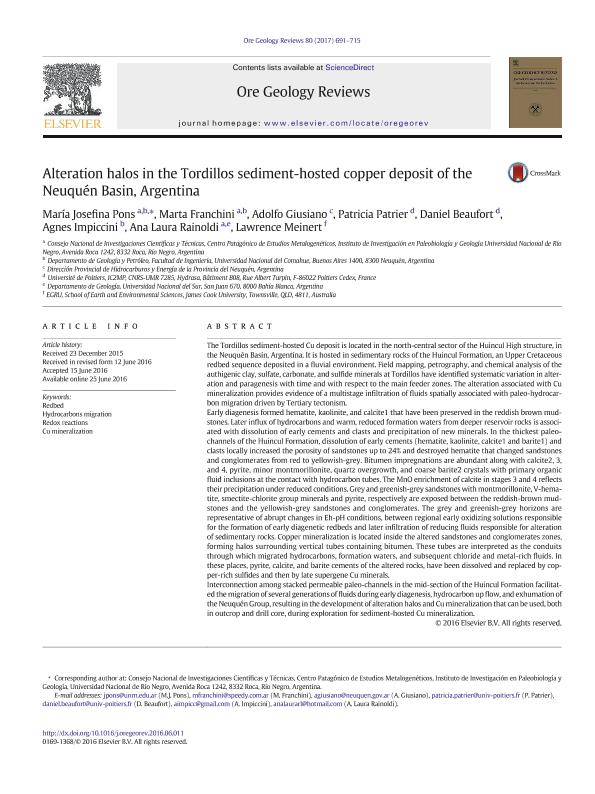Mostrar el registro sencillo del ítem
dc.contributor.author
Pons, María Josefina

dc.contributor.author
Franchini, Marta Beatriz

dc.contributor.author
Giusiano, Adolfo Eugenio

dc.contributor.author
Patrier, Patricia
dc.contributor.author
Beaufort, Daniel
dc.contributor.author
Impiccini, Agnes

dc.contributor.author
Rainoldi, Ana Laura

dc.contributor.author
Meinert, Lawrence
dc.date.available
2018-12-13T22:13:44Z
dc.date.issued
2017-01
dc.identifier.citation
Pons, María Josefina; Franchini, Marta Beatriz; Giusiano, Adolfo Eugenio; Patrier, Patricia; Beaufort, Daniel; et al.; Alteration halos in the Tordillos sediment-hosted copper deposit of the Neuquén Basin, Argentina; Elsevier Science; Ore Geology Reviews; 80; 1-2017; 691-715
dc.identifier.issn
0169-1368
dc.identifier.uri
http://hdl.handle.net/11336/66480
dc.description.abstract
The Tordillos sediment-hosted Cu deposit is located in the north-central sector of the Huincul High structure, in the Neuquén Basin, Argentina. It is hosted in sedimentary rocks of the Huincul Formation, an Upper Cretaceous redbed sequence deposited in a fluvial environment. Field mapping, petrography, and chemical analysis of the authigenic clay, sulfate, carbonate, and sulfide minerals at Tordillos have identified systematic variation in alteration and paragenesis with time and with respect to the main feeder zones. The alteration associated with Cu mineralization provides evidence of a multistage infiltration of fluids spatially associated with paleo-hydrocarbon migration driven by Tertiary tectonism. Early diagenesis formed hematite, kaolinite, and calcite1 that have been preserved in the reddish brown mudstones. Later influx of hydrocarbons and warm, reduced formation waters from deeper reservoir rocks is associated with dissolution of early cements and clasts and precipitation of new minerals. In the thickest paleo-channels of the Huincul Formation, dissolution of early cements (hematite, kaolinite, calcite1 and barite1) and clasts locally increased the porosity of sandstones up to 24% and destroyed hematite that changed sandstones and conglomerates from red to yellowish-grey. Bitumen impregnations are abundant along with calcite2, 3, and 4, pyrite, minor montmorillonite, quartz overgrowth, and coarse barite2 crystals with primary organic fluid inclusions at the contact with hydrocarbon tubes. The MnO enrichment of calcite in stages 3 and 4 reflects their precipitation under reduced conditions. Grey and greenish-grey sandstones with montmorillonite, V-hematite, smectite-chlorite group minerals and pyrite, respectively are exposed between the reddish-brown mudstones and the yellowish-grey sandstones and conglomerates. The grey and greenish-grey horizons are representative of abrupt changes in Eh-pH conditions, between regional early oxidizing solutions responsible for the formation of early diagenetic redbeds and later infiltration of reducing fluids responsible for alteration of sedimentary rocks. Copper mineralization is located inside the altered sandstones and conglomerates zones, forming halos surrounding vertical tubes containing bitumen. These tubes are interpreted as the conduits through which migrated hydrocarbons, formation waters, and subsequent chloride and metal-rich fluids. In these places, pyrite, calcite, and barite cements of the altered rocks, have been dissolved and replaced by copper-rich sulfides and then by late supergene Cu minerals. Interconnection among stacked permeable paleo-channels in the mid-section of the Huincul Formation facilitated the migration of several generations of fluids during early diagenesis, hydrocarbon up flow, and exhumation of the Neuquén Group, resulting in the development of alteration halos and Cu mineralization that can be used, both in outcrop and drill core, during exploration for sediment-hosted Cu mineralization.
dc.format
application/pdf
dc.language.iso
eng
dc.publisher
Elsevier Science

dc.rights
info:eu-repo/semantics/openAccess
dc.rights.uri
https://creativecommons.org/licenses/by-nc-sa/2.5/ar/
dc.subject
Cu Mineralization
dc.subject
Hydrocarbons Migration
dc.subject
Redbed
dc.subject
Redox Reactions
dc.subject.classification
Meteorología y Ciencias Atmosféricas

dc.subject.classification
Ciencias de la Tierra y relacionadas con el Medio Ambiente

dc.subject.classification
CIENCIAS NATURALES Y EXACTAS

dc.title
Alteration halos in the Tordillos sediment-hosted copper deposit of the Neuquén Basin, Argentina
dc.type
info:eu-repo/semantics/article
dc.type
info:ar-repo/semantics/artículo
dc.type
info:eu-repo/semantics/publishedVersion
dc.date.updated
2018-10-23T20:18:55Z
dc.journal.volume
80
dc.journal.pagination
691-715
dc.journal.pais
Países Bajos

dc.journal.ciudad
Amsterdam
dc.description.fil
Fil: Pons, María Josefina. Consejo Nacional de Investigaciones Científicas y Técnicas. Centro Científico Tecnológico Conicet - Patagonia Norte. Instituto de Investigación en Paleobiología y Geología; Argentina. Universidad Nacional del Comahue. Facultad de Ingeniería. Departamento de Geología y Petróleo; Argentina
dc.description.fil
Fil: Franchini, Marta Beatriz. Consejo Nacional de Investigaciones Científicas y Técnicas. Centro Científico Tecnológico Conicet - Patagonia Norte. Instituto de Investigación en Paleobiología y Geología; Argentina. Universidad Nacional del Comahue. Facultad de Ingeniería. Departamento de Geología y Petróleo; Argentina
dc.description.fil
Fil: Giusiano, Adolfo Eugenio. Provincia de Neuquén. Dirección Provincial de Hidrocarburos y Energía; Argentina
dc.description.fil
Fil: Patrier, Patricia. Université de Poitiers; Francia
dc.description.fil
Fil: Beaufort, Daniel. Université de Poitiers; Francia
dc.description.fil
Fil: Impiccini, Agnes. Universidad Nacional del Comahue. Facultad de Ingeniería. Departamento de Geología y Petróleo; Argentina
dc.description.fil
Fil: Rainoldi, Ana Laura. Consejo Nacional de Investigaciones Científicas y Técnicas. Centro Científico Tecnológico Conicet - Patagonia Norte. Instituto de Investigación en Paleobiología y Geología; Argentina. Universidad Nacional del Sur. Departamento de Geología; Argentina
dc.description.fil
Fil: Meinert, Lawrence. James Cook University; Australia
dc.journal.title
Ore Geology Reviews

dc.relation.alternativeid
info:eu-repo/semantics/altIdentifier/doi/http://dx.doi.org/10.1016/j.oregeorev.2016.06.011
dc.relation.alternativeid
info:eu-repo/semantics/altIdentifier/doi/https://www.sciencedirect.com/science/article/pii/S0169136815303024
Archivos asociados
